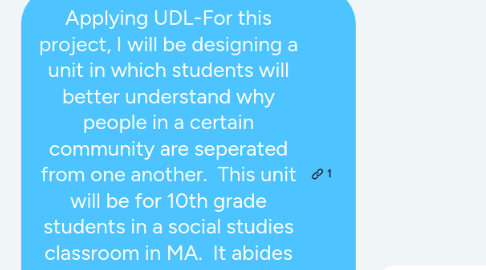
1. How will students be motivated and engaged?
1.1. UDL At a Glance (2009), explains the importance of including the why, what, and how of everything that is being taught in the classroom. By including all three of these aspects within my lessons, I will be able to cater to many different learning styles and therefore keep students motivated and engaged.
1.2. One way that students will be motivated and engaged is through real life application. At the end of the unit, students will be required to submit a letter to a person in their community that may have some say in a change. This letter is a real life scenario that hopefully students will want to succeed with.
1.3. Another way students will be motivated and engaged is by teaching the topic through a real life lens. By making the issue of segregation something that students realize is a problem today and not just of the past, the goal is for students to stay motivated through feeling empathy towards minority groups that are struggling with this issue.
1.4. It is also important that each lesson is presented in a way that interests students, for that I plan on using many different resources such as picture books, primary sources, videos, readings, and research so that a variety of students will be provided with different ways of grasping the material.
2. How will the lessons be presented?
2.1. According to UDL At a Glance (2009), it is very important for educators to present information in different ways so that you tailor the information to different style learners.
2.2. Lessons will be presented in a variety of different ways
2.2.1. One way lessons will be presented is through group work. Students will work in partners to discover a variety of different aspects regarding segregation. One specific example of this is students splitting analyzing primary source documents from when desegregation in America began.
2.2.2. Another way lessons will be presented is through homework. As lessons progress, students will need to complete readings for homework that will then be discussed the next day in class. These readings will be vital for students to have a brief understanding on the material prior to arriving in class. Once arriving in class, the teacher will be able to address any concerns the student may have with the material.
2.2.2.1. One way of differentiating this particular lesson is through an abridged version of the text. As the teacher, I will abridge the text for students who may not be at the reading level necessary to understand the material.

